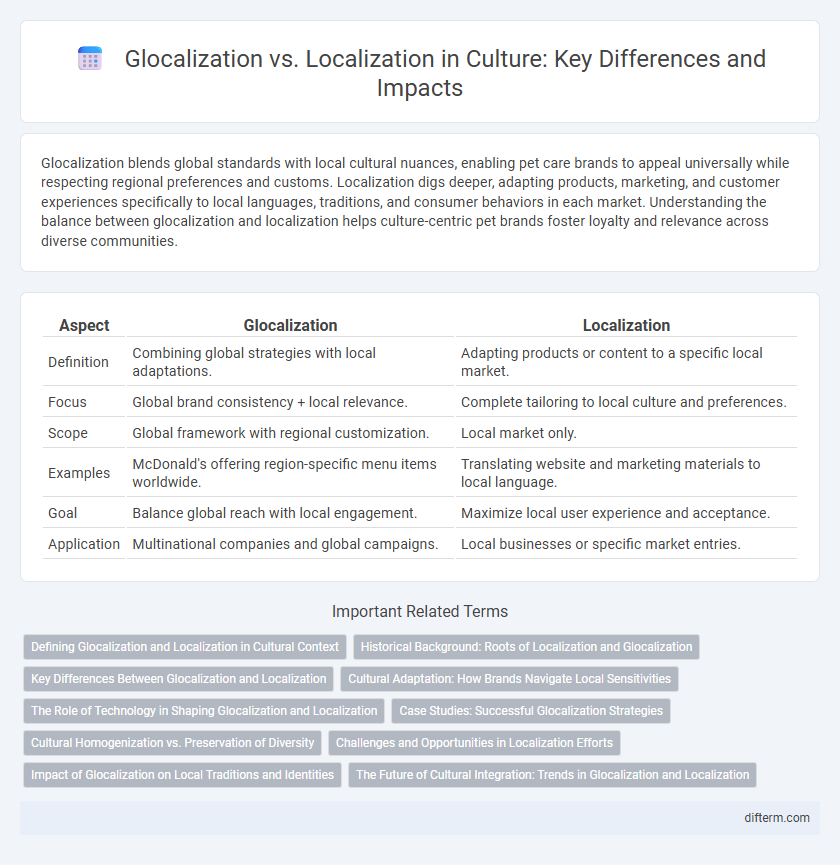Glocalization blends global standards with local cultural nuances, enabling pet care brands to appeal universally while respecting regional preferences and customs. Localization digs deeper, adapting products, marketing, and customer experiences specifically to local languages, traditions, and consumer behaviors in each market. Understanding the balance between glocalization and localization helps culture-centric pet brands foster loyalty and relevance across diverse communities.
Table of Comparison
| Aspect | Glocalization | Localization |
|---|---|---|
| Definition | Combining global strategies with local adaptations. | Adapting products or content to a specific local market. |
| Focus | Global brand consistency + local relevance. | Complete tailoring to local culture and preferences. |
| Scope | Global framework with regional customization. | Local market only. |
| Examples | McDonald's offering region-specific menu items worldwide. | Translating website and marketing materials to local language. |
| Goal | Balance global reach with local engagement. | Maximize local user experience and acceptance. |
| Application | Multinational companies and global campaigns. | Local businesses or specific market entries. |
Defining Glocalization and Localization in Cultural Context
Glocalization in a cultural context refers to the adaptation of global products or ideas to fit local cultures, blending universal appeal with regional specifics. Localization focuses more narrowly on modifying content and experiences to align strictly with the cultural norms, language, and preferences of a specific geographic area. Both concepts emphasize cultural relevance but differ in scope, with glocalization integrating global and local elements and localization concentrating exclusively on local adaptation.
Historical Background: Roots of Localization and Glocalization
The historical roots of localization trace back to early trade and colonization efforts where adapting products and messages to local languages and customs was essential for market acceptance. Glocalization emerged from a blend of globalization theories in the late 20th century, emphasizing the simultaneous importance of global integration and local responsiveness in cultural exchange. Both concepts highlight how cultural dynamics shape economic and social interactions, reflecting an ongoing negotiation between universal standards and local identities.
Key Differences Between Glocalization and Localization
Glocalization involves adapting global products or services to fit local cultures while maintaining a consistent global brand identity, whereas localization focuses solely on tailoring content or products to meet specific local preferences and linguistic requirements. Glocalization balances global standardization with local customization, ensuring cultural relevance and brand coherence across different markets. Localization is more narrowly centered on translation, cultural adaptation, and meeting local regulatory or market needs without necessarily preserving a unified global strategy.
Cultural Adaptation: How Brands Navigate Local Sensitivities
Glocalization involves integrating global brand values with local cultural nuances to create products and messages that resonate authentically within diverse markets. Localization emphasizes adapting content, design, and communication to meet the specific cultural, linguistic, and societal norms of a target region. Both strategies prioritize cultural adaptation by addressing local sensitivities, ensuring brand relevance, and fostering deeper consumer connections across varied cultural landscapes.
The Role of Technology in Shaping Glocalization and Localization
Technology acts as a catalyst in glocalization by enabling global brands to adapt products and services to local cultures through data analytics, AI, and digital communication platforms. Localization leverages technological tools such as translation software, content management systems, and geo-targeted advertising to tailor user experiences to specific regional languages and preferences. The integration of these technologies accelerates cultural customization, allowing businesses to navigate diverse markets effectively while maintaining global coherence.
Case Studies: Successful Glocalization Strategies
Global brands like McDonald's and Netflix exemplify successful glocalization by adapting their products and services to local cultures while maintaining their core identity. McDonald's customizes menus with regional flavors such as the McSpicy Paneer in India, enhancing local relevance and customer engagement. Netflix invests in producing original content tailored to specific markets, like the Spanish series "La Casa de Papel," driving global expansion through culturally resonant storytelling.
Cultural Homogenization vs. Preservation of Diversity
Glocalization balances global influences with local cultural traits, mitigating the risks of cultural homogenization by adapting global products and ideas to fit diverse cultural contexts. Localization emphasizes preserving unique cultural identities by tailoring content and practices specifically to local customs, languages, and traditions. Both strategies impact cultural diversity, with glocalization fostering hybrid cultures while localization prioritizes maintaining distinct cultural heritage.
Challenges and Opportunities in Localization Efforts
Localization efforts face challenges such as linguistic nuances, cultural misunderstandings, and resource allocation, which can impact brand consistency and audience engagement. Opportunities in effective localization include enhanced market relevance, improved user experience, and stronger emotional connections with local consumers. Balancing global brand identity with local cultural preferences enables companies to scale internationally while maintaining authenticity.
Impact of Glocalization on Local Traditions and Identities
Glocalization blends global influences with local customs, reshaping traditions without erasing cultural identities. It encourages the adaptation of global products and ideas to fit local tastes, preserving unique heritage while fostering innovation. This dynamic process strengthens cultural diversity by allowing communities to maintain their distinctiveness amid global interconnectedness.
The Future of Cultural Integration: Trends in Glocalization and Localization
The future of cultural integration hinges on the dynamic interplay between glocalization and localization, where global brands adapt to local cultures while preserving a cohesive international identity. Emerging trends emphasize hyper-personalization and immersive technologies that enable authentic cultural experiences tailored to specific communities. This evolution fosters deeper consumer engagement by balancing global consistency with local relevance, driving sustainable multicultural connections.
Glocalization vs Localization Infographic

 difterm.com
difterm.com